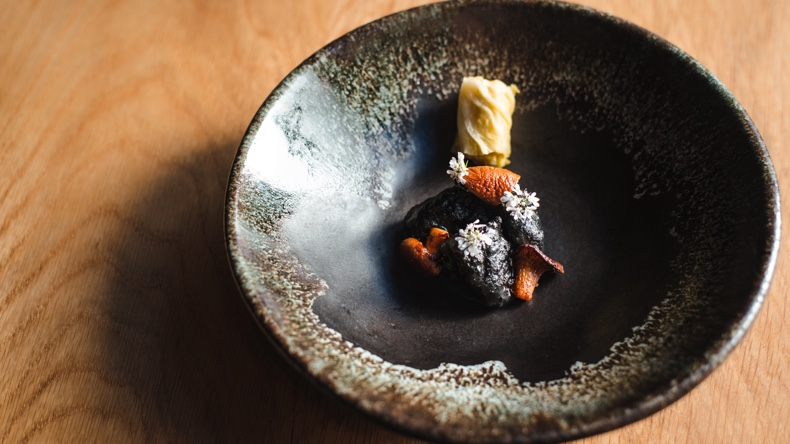Chefs and Restaurants
David Yoshimura Expresses the Harmony of Washoku Cuisine at Nisei
Chef David Yoshimura wants his guests to know there’s so much more to Japanese cuisine than raw fish and ramen. “In America, a lot of people think Japanese food has to be sushi if it’s going to be good,” says Yoshimura. “What I really want to convey is that there’s a lot more to it than sushi.”
Opened last August in San Francisco’s Russian Hill neighborhood, his restaurant Nisei allows him to do just that, offering a multi-course, multi-hour, fine-dining escapade and exploration into Japanese washoku cuisine through a California lens.
Washoku, which translates to “harmony of food,” is at its essence traditional Japanese home cooking. It’s the oldest style of Japanese food, predating sushi; it is what kaiseki evolved from.
Guiding principles behind washoku include seasonality, simplicity, and balance, which is best exemplified through the arrangement and pairing of “ichiju sansai” (one soup, three dishes). Other familiar examples of washoku cuisine include Japanese curry with rice or oyakodon (chicken and egg bowl). In longer coursed-out washoku meals, there will also be a number of techniques involved like simmering, grilling, and frying, similar to kaiseki meals.
“Washoku is a broad term that has evolved over the years,” explains Yoshimura. “Soul food is another loose translation for it.”
Nisei is a highly personal restaurant for Yoshimura. The word Nisei translates to “second generation” and is used to refer to those born in the United States or Canada by Japanese immigrants. Yoshimura was born and raised in Houston and is half Japanese—his father emigrated from Japan.
“I always wanted to open up my own restaurant, and I kept searching for what I wanted to make,” says Yoshimura. On washoku cuisine, he adds, “It made sense, because that’s what I grew up eating—that’s what I like to eat, it’s who I am.”
Yoshimura’s culinary CV is impressive: After graduating high school, he moved to New York, where he attended The Culinary Institute of America in Hyde Park. He worked at wd~50 and traveled to Spain and Japan, where he staged at Michelin-starred restaurants like Asador Etxebarri and Kohaku, respectively.
Yoshimura moved to San Francisco in 2015 to start a new chapter in his life. “San Francisco is, in my opinion, the best city on the West Coast for food.” He joined the team at the modern Mexican restaurant Californios, where he would become the chef de cuisine under Val Cantu. The restaurant received its first Michelin star within the first year.
Californios proved to provide crucial experience and inspiration for Yoshimura, who saw what Cantu was doing with Mexican cuisine. “People always think Mexican food is just tacos, but Val showed that it was so much more,” says Yoshimura. “I really respected that.” It’s easy to see the parallels in concepts and goals between what Cantu does with Californios and Mexican cuisine and what Yoshimura does with Nisei and Japanese cuisine, with each chef offering their vision and version of elevated technique and a fine-dining approach to what may ordinarily be simple fare.
“The reason I brought a fine-dining aspect is because that’s where the bulk of my training comes from,” says Yoshimura. “I really only worked in fine dining, so it kind of made sense to combine the two.”
Californios also provided Yoshimura with the push to further his wine knowledge. “Charlotte [Randolph] and Val both pushed wine knowledge, and I kept poking and prodding,” he says.
Yoshimura poked and prodded so much that he became a certified sommelier.
“I always thought chefs should have a base knowledge of wine,” says Yoshimura. “And if I was going to open my own restaurant, I wanted to feel confident in my knowledge.”
Yoshimura brings that same focus to Nisei; his general manager is also a certified sommelier, and the team regularly takes trips to wine country.
Wine pairings at Nisei showcase Champagnes, rieslings, Riojas, and sake. “I wanted to show that you can take something humble like curry and rice and pair wine with it,” says Yoshimura.
Yoshimura’s curry dish is hardly humble. The Japanese curry is made with mirepoix, to which he adds apple and banana to sweeten, along with a mix of warming spices like coriander, cumin, turmeric, and fennel. He cooks it all down with sake, mirin, soy sauce, and chicken stock and adds squid ink to create a color darker than night (recipe). When they’re in season, he mixes in morel mushrooms to soak up the sauce like a sponge, and anchors the dish with a generous slice of A5 Wagyu from the Miyazaki Prefecture that’s breaded and deep-fried until crispy—one of the tastiest bites of katsu ever created.
Yoshimura pairs the rich, earthy dish with a shiny, golden, medium-dry Madeira—it’s slightly sweet and cuts through the dish nicely. It’s safe to say that the whole affair isn’t your traditional washoku experience.
When asked about his goals and aspirations for Nisei, Yoshimura says, “I’m shooting very high—I aspire for the whole restaurant to go as far as we can go. I have a talented staff and we have potential to do that.”
Omar Mamoon is a San Francisco-based freelance writer and cookie dough professional.

